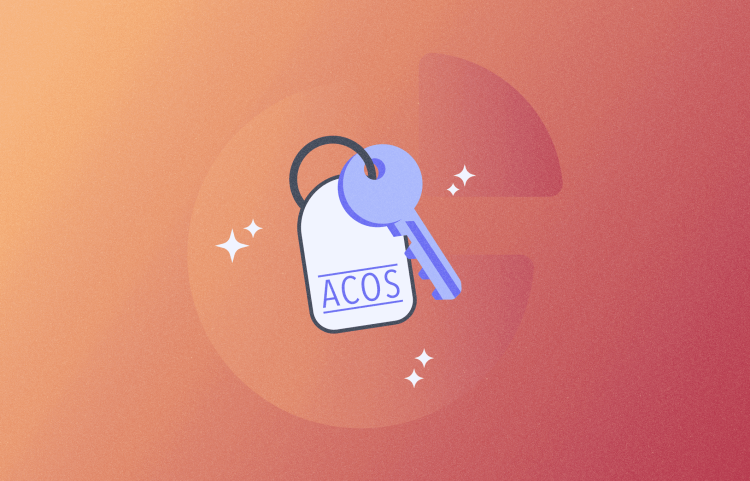
Amazon Total ACoS (TACoS): Introduction to a Key Ad Metric
Martin Saunders, July 25, 2024
Table of Contents
Amazon TACoS (total advertising cost of sale) is a key metric for understanding your business’s relationship to advertising. For sellers who are unfamiliar with what TACoS is or how to interpret it, we’ll cover all of the information you need to know, like:
how to calculate TACoS
what your Amazon TACoS means
why it is useful for brands on Amazon
top TACoS use cases.
TL;DR? Listen instead
What is Amazon TACoS?
Amazon TACoS, or total advertising cost of sale, measures the relationship between ad spend and total sales. In other words, it is the ratio of ad spend to total sales (in %). You can calculate your TACoS on Amazon with this formula:

Please note: TACoS is NOT “Target ACoS,” which is a completely different advertising concept.
What is the difference between TACoS and ACoS?
ACoS stands for advertising cost of sale. It is calculated by dividing ad spend by ad sales, and it measures the efficiency of your advertising campaign.

TACoS, on the other hand, takes total sales into consideration — that is, both ad sales and organic sales.

Why should I use TACoS?
TACoS can be used to:
understand your overall profitability
monitor reliance on advertising for your account or specific products
analyze the effect of ad sales on organic sales.
At the heart of the metric TACoS is the idea that ad sales drive organic sales and that this effect can cause positive and negative sales cycles.
A positive sales cycle occurs when an increase in ad spend leads to an increase in ad sales, and those ad sales, in turn, improve organic ranking (and the number of reviews) and lead to more organic sales.
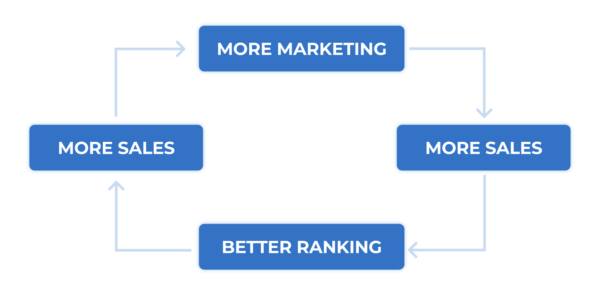
A negative sales cycle is triggered in a similar way to a positive sales cycle. A decrease in ad spend leads to a decrease in ad sales, which leads to poorer organic rankings and fewer organic sales.

How Can I Use TACoS to Improve My Business?
Use case 1: Monitor overall business profitability after advertising
Using Amazon TACoS to calculate total net profit margin
To see whether your business model is profitable, we need to calculate the total net profit margin. Let’s look at an example of how we can do this with TACoS:
Let’s say ad spend is $2,500 and total sales are $30,000. Using the formula from above, we’ll divide ad spend ($2,500) by total sales ($30,000) and multiply that by 100, which would give us a TACoS of 8.33%.

Next, we’ll subtract TACoS from our organic profit margin — our profit margin before advertising. (In this example, we assume the organic profit margin is 25%.) The result will be the net profit margin.

Because TACoS is less than the organic profit margin, we know that the overall business model is profitable, with a total net profit margin of 16.67%.
IF TACoS < organic profit margin, THEN your overall business is profitable after advertising
Tracking total advertising profitability over time
Decreasing Amazon TACoS

Generally, a decreasing TACoS indicates increasing total advertising profitability. A downward sloping TACoS most often indicates one of the following situations:
total sales are increasing and ad spend is increasing but at a lower rate;
total sales are increasing and advertising spend is not changing;
total sales are flat and ad spend is decreasing.
An increasing TACoS

An increasing TACoS indicates that total ad profitability is decreasing.
One of the following situations typically leads to an increasing TACoS:
ad spend is increasing and total sales are not changing;
ad spend is increasing and total sales are increasing (but at a slower rate);
advertising spend is not changing and total sales are decreasing.
Note: an increasing TACoS is not necessarily a bad thing if you are investing heavily in advertising to launch a new product, maximize sales, increase market share, or drive brand awareness.
In these situations, it is normal to see your TACoS increase for a period of time. In the long run, however, you’ll want to have a decreasing TACoS or a flat TACoS.
In Perpetua's sales and traffic tab, you can easily see how your TACoS is trending over time and make adjustments to your PPC strategy accordingly. Check it out today!
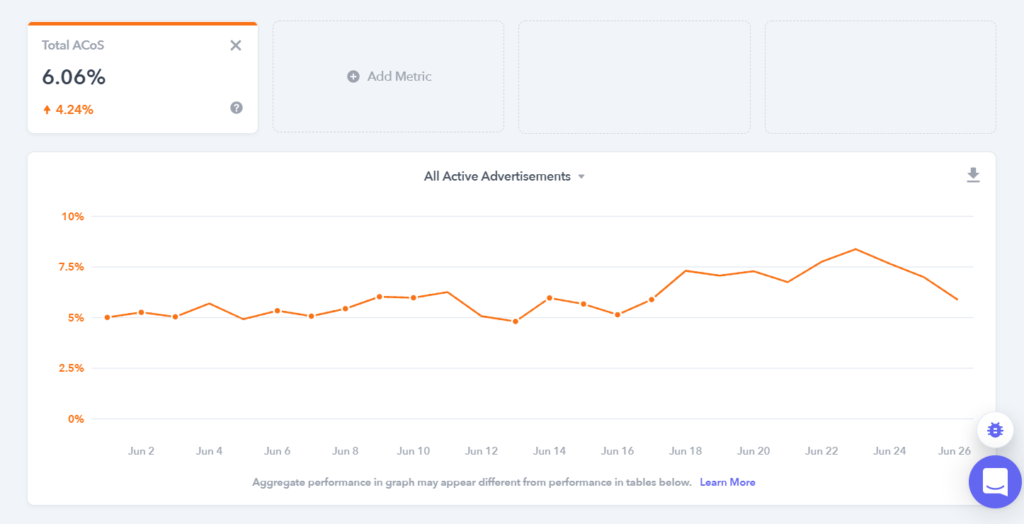
Use case 2: Understanding how dependent individual products are on advertising
very high TACoS on Amazon = high dependence on advertisingvery low TACos = advertising is underutilized
By looking at TACoS levels across your portfolio, you can identify products that are too dependent on advertising and products that do not benefit enough from advertising.
Very high product TACoS
If an individual product’s TACoS is significantly higher than the rest of your product portfolio, this means that the product is highly dependent on advertising.
Optimizing the product’s listing (copy, images, videos, reviews) will increase its click-through rate and conversion rate so that more ad sales and organic sales are generated. This, in turn, will increase the chances of starting a positive sales cycle.
Very low product TACoS
On the other hand, a very low TACoS means that ad spend and ad sales are much lower than other products in your portfolio.
This might indicate that you have a product that has strong organic rankings and sales. However, it also means that it could be a good idea to increase ad spend (or optimize your ads) to increase overall sales by driving ad sales and in turn organic sales.
Use case 3: Identifying positive and negative sales cycles
To identify positive and negative sales cycles, you can look at the relationship between Amazon ACoS and TACoS.
A positive sales cycle
Brands on Amazon invest in advertising for a number of reasons, like:
launching a new product
for a seasonal campaign (e.g., Christmas)
to spark an increase in sales.
Ideally, an increase in ad sales also drives more organic sales. To see if this happens you can monitor TACoS.
An increase in ad spend typically leads to a short-term increase in both ACoS and TACoS (here from Q1 to Q2).

As ACoS stabilizes on a higher level (in Q2), TACoS should ideally begin to decrease, indicating that a positive cycle of more organic sales has been triggered.
As a quick reminder: A positive sales cycle occurs when an increase in ad sales improves organic rankings (and the number of reviews), leading to more organic sales, which in turn further improves organic rankings and sales.
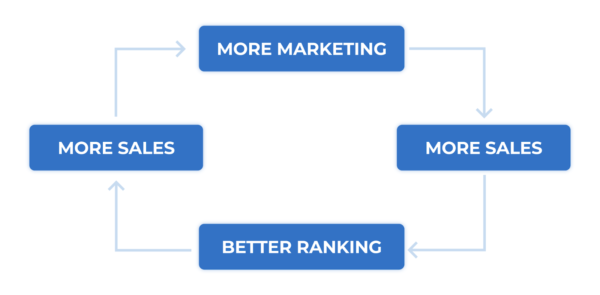
A negative sales cycle
Brands on Amazon often reduce ad spend to quickly cut costs or to optimize ACoS over time. When reducing ad spend, you should monitor TACoS to see if a negative sales cycle has started that needs to be stopped.
Normally, when you decrease ad spend there will be a short-term decrease in ACoS and TACoS. Then both ACoS and TACoS should stabilize. If ACoS has stabilized and TACoS is increasing, however, this indicates that a negative cycle of fewer organic sales has been triggered.

Just to recap: A negative sales cycle occurs when a decrease in ad spend leads to a decrease in ad sales, which in turn leads to poorer organic rankings and fewer organic sales.

What you cannot read from TACoS
In most cases, looking at the slopes of the TACoS and ACoS trend lines (i.e. comparing which line is increasing/decreasing faster) will not provide enough information to determine which underlying variable is driving changes in the metrics.
This is because TACoS and ACoS tend to move in the same direction and are determined by several different variables that could be driving changes (ad spend, ad sales, and organic sales). In most cases, this makes it impossible to determine which variable is causing changes in the metrics just by looking at the slopes of the trend lines.
Only when ACoS is stable can you tell which underlying variable is leading to changes in TACoS and ACoS by looking at the trend lines.
Flat Amazon TACoS and ACoS

When both TACoS and ACoS are stable (or fluctuating around a certain level), this indicates neither a positive nor a negative sales cycle has been triggered.
This can occur when an advertising campaign is highly optimized, or when there have not been any adjustments made to an advertising campaign.
While a flat Amazon TACoS is not a bad thing, most advertisers would want to see it decreasing slightly over time, as the brand gains recognition, organic rankings improve, and organic sales build momentum.
Tip: You can easily monitor and compare your ACoS and TACoS in Perpetua's performance dashboard.
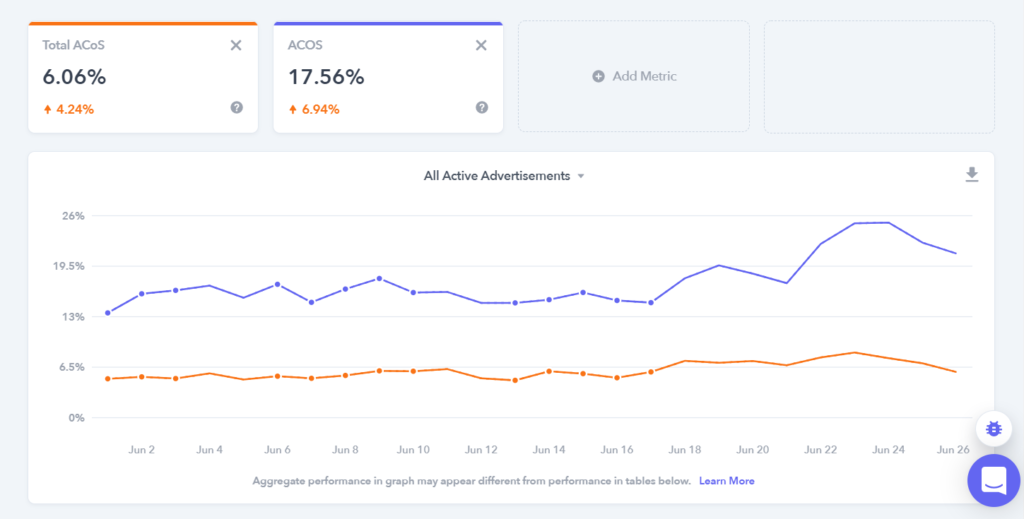
Worried about your ACoS?
You can easily reach your desired ACoS with Perpetua’s Ad Engine. Simply set your target ACoS, and our software will automatically adjust your bids, saving time and effort. If you’d like to maintain more control, you can use our advanced levers to create a setup customized to your specific needs.
How Can I Improve My TACoS on Amazon?
To achieve a decreasing Amazon TACoS, one of the following situations needs to happen:
Situation 1: ad spend decreases while total sales stay the same or increase (e.g. by using negative keywords to cut wasted ad spend);
Situation 2: ad spend stays the same while total sales increase (e.g. by moving budget to more efficient targets);
Situation 3: ad spend increases but total sales increase at a faster rate (e.g. by increasing ad spend for an optimized and high-converting product listing).
Below, we’ll outline how you can drive your TACoS lower by improving ad efficiency and boosting organic sales.
Do I need a decreasing TACoS?
A stable TACoS (or a TACoS fluctuating around a certain level) is not necessarily a bad thing; it indicates that the relationship between ad spend and total sales is steady. This can be a sign of a mature brand.
Also, a very low TACoS is not necessarily a good thing. It could mean that you’re underinvesting in advertising and missing out on sales.
Improve ad efficiency
One of the most effective ways to cut wasted ad spend (situation 1 above) and boost your ad sales (situations 2 and 3) is to optimize your Amazon ads.
To do so, you can focus on improving the following metrics:
click-through rate: drive more traffic to your to your product detail page;
cost per click (CPC): make sure your bids are competitive, while not overpaying for ads;
conversion rate: attaining a higher conversion rate means more profitable ads;
average order value: assuming all else equal, a higher average order value equates to higher profitability.
How can I improve click-through rate?
Optimize your campaign targeting: Do Amazon keyword research (e.g., with Amazon’s SQP report or with Prism) to identify the most relevant keywords for your brand.
Improve product images: Ensure your images adhere to Amazon’s quality, background, angle, and perspective requirements.
Maximize star rating: Improve your products and product detail pages based on negative customer reviews. Regularly update the product FAQ section to address common questions, clarify usage instructions, and offer troubleshooting tips.
Optimize ad placements: Increase your bids for placements with a high click-through rate (like Top of Search) with bid placement modifiers.
How can I improve cost per click?
Determine your advertising goal and target ACoS. Is your goal to maximize sales or impressions (higher target ACoS or break-even ACoS), or is it to run a profitable campaign (lower target ACoS)? Define a target ACoS for each campaign/ad group to optimize your cost per click.
Always-on bid optimization: Depending on the target ACoS, competition, and conversion rates, the optimal CPC for keywords in your campaigns will vary. Set up automated bidding to ensure your bids are always optimized.
How can I enhance my conversion rate?
Optimize your product content: images, titles, bullet points, description, A+ Content, videos.
Craft a persuasive Amazon listing: provide all necessary information for a purchase decision; tell customers how your product can benefit them; use A+ Content and be sure to follow Amazon’s style guide.
Set up dynamic bidding to allow Amazon to increase or decrease your bid based on the likelihood of conversion. Set up placement modifiers for bids to increase bids for placements with higher conversion rates.
What is the right average order value?
Average order value is an often-overlooked factor that has a large impact on TACoS. The higher your average order value, the better your TACoS will be, assuming all other metrics stay the same.
The three factors that will influence your average order value are:
the price a buyer is willing to pay
the price a seller (you) is willing to accept
the price that’s competitive in the market.
We recommend that you A/B test prices to find the average order value that works best for your business. For more information about pricing strategies, check out our blog article on pricing strategy.
Boost your organic sales
Apart from using Amazon advertising in an effective way, the best way to bring in strong organic sales is with an optimized product listing.
This means you need to:
make sure the listing’s search terms are relevant and up to date;
optimize your product content: images, titles, bullet points, description, A+ Content, videos;
manage your product reviews and questions.
How can I ensure my product listing’s search terms are up to date?
The search terms that appear in your listing are one of the primary ways that Amazon determines whether your product matches customer search queries. Two tools that you can use to identify the high-impact search terms that should be in your listing are: Amazon's Search Query Performance Report and Prism.
Using Amazon’s Search Query Performance Report for search term research
One of the best free resources for doing keyword research is Amazon’s Search Query Performance (SQP) Report. You can use Amazon’s SQP report to:
Get ideas for new keywords: map relevant search terms with the targeted keywords in your existing PPC campaigns and look for search terms that are related to your product that you’re not targeting.
Improve Amazon SEO: sort your Search Query Performance data by Impression Share (last period) and add highly relevant queries with low impression share to the title, bullet points, and/or the backend keywords.
Measure the impact of A/B testing, deals, and listing optimization: monitoring click share, impression share, and purchase share to understand changes to your product’s positioning in the market.
For more information check out our webinar on how to use Amazon’s Search Query Performance Report.
Using Prism for search term research
With Prism, you can identify and target the keywords where competitors are outranking you. Prism shows you:
the top search terms for the market you’ve defined
the search rank frequency (SRF) for each search term
your and your competitors’ standing in Amazon’s organic rankings and the percentage of shopper searches in which your ASIN did not show up in the top of search ad placements.
With this information, you can easily identify high-impact search terms to include in your listing and in your backend keywords.
Optimizing product content
Having highly-optimized product content maximizes the chances that Amazon's search algorithm will match your product to relevant search queries.
Here are some quick-and-dirty tips for optimizing product content:
Product Title: Aim for no more than 150 characters. Include your brand name, product name, key differentiating attributes, size, and quantity. Use a capital letter to start each word and keep a consistent structure across your product portfolio. Bonus points for establishing your brand tone in your title.
Bullet Points: Include a minimum of five bullet points on product features. Start each bullet feature with capitalization or a key point giving the audience a glimpse into what it will be about. Capture the audience’s interest quickly. Stick to essential features that you think shoppers will have an interest in, such as size, material, functionality, durability and style.
Product Description: Include more details about the product that didn’t fit into the title or bullet points, making sure to include additional keywords that could improve search ranking.
For more best practices on product content read this blog article.
Managing product reviews and questions
Managing customer feedback and inquiries is critical to boosting organic sales. Make sure to take the following steps:
Product reviews: Read all of your reviews and make adjustments to your product and product description accordingly.
FAQ section: Regularly update the FAQ section based on customer feedback and common questions received. Use the FAQ section to address potential after-purchase issues and questions that might arise.
Amazon TACoS: Final Thoughts
Looking at Amazon TACoS is a great way to put your ad spend into perspective because it brings your total revenue into the picture. In doing so, it captures the impact your advertising and ad sales have on organic revenue.
When analyzing your brand’s business on Amazon, TACoS is also useful for:
determining net profit margin and tracking total advertising profitability over time
understanding how dependent individual products are on advertising
Identifying positive and negative sales cycles.
Amazon Total ACoS (TACoS) FAQ
What is Amazon TACOS?
What is the difference between ACoS, TACoS, and RoAS?
What is a good TACoS for Amazon PPC?
What is the formula for ACoS vs. TACoS?
What does ACoS mean?
To get started or learn more about how Perpetua can help you scale your Amazon Advertising business, contact us at hello@perpetua.io